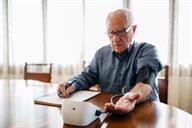ThisisPatientEngagementcontent
How to Take Your Blood Pressure (Easy to Read)
Learn more about our Patient Engagement products now! Turn your patients into active participants in their healthcare by giving them easy access to the same evidence-based information you trust – but delivered in an easy-to-understand format.
Blood pressure measures how strongly your blood is pressing against the walls of your arteries. Arteries are blood vessels that carry blood from your heart throughout your body. You can take your blood pressure at home with a machine.
You may need to check your blood pressure at home: Follow the instructions that came with your machine. If you have a digital blood pressure monitor, these may be the instructions:
Follow the instructions that came with your machine. If you have a digital blood pressure monitor, these may be the instructions:Two numbers make up your blood pressure. The first number is called systolic pressure. The second is called diastolic pressure. An example of a blood pressure reading is "120 over 80" (or 120/80).
If you are an adult and do not have a medical condition, use this guide to find out if your blood pressure is normal:
Normal
Elevated
Hypertension stage 1
Hypertension stage 2
Your blood pressure is above normal even if only the first or only the second number is above normal.
Medicines
General instructions
General tips
You will need a blood pressure machine or monitor. Your doctor can suggest a monitor. You can buy one at a drugstore or online. When choosing one:American Heart Association: www.heart.org
These symptoms may be an emergency. Do not wait to see if the symptoms will go away. Get help right away. Call 911.
This information is not intended to replace advice given to you by your health care provider. Make sure you discuss any questions you have with your health care provider.
Cookies are used by this site. To decline or learn more, visit our cookie notice.
Copyright © 2025 Elsevier, its licensors, and contributors. All rights are reserved, including those for text and data mining, AI training, and similar technologies.